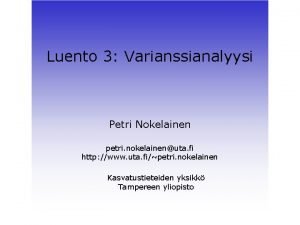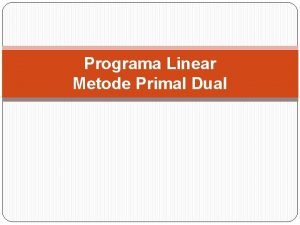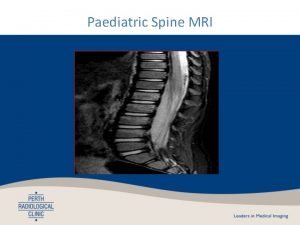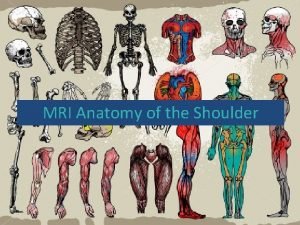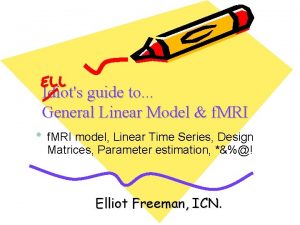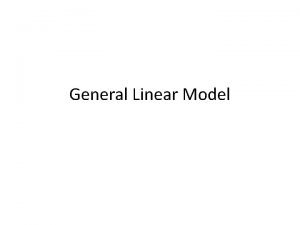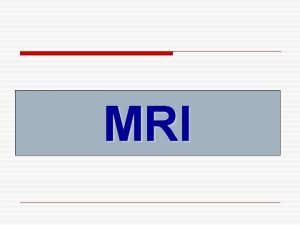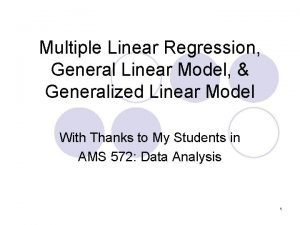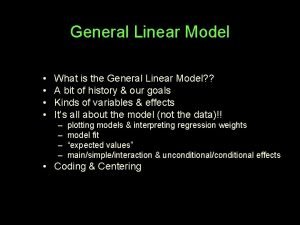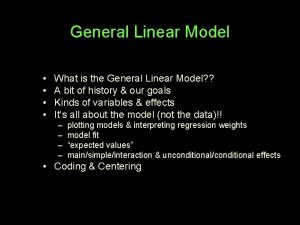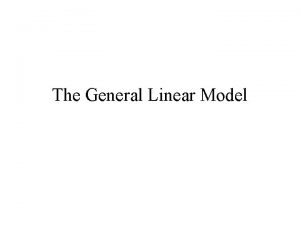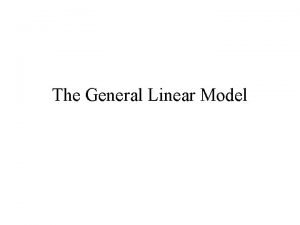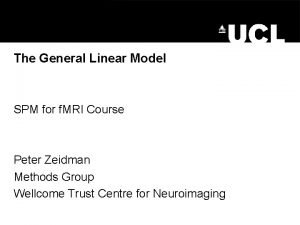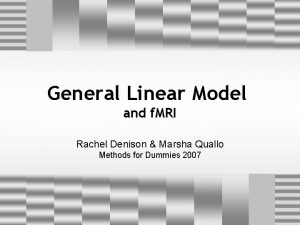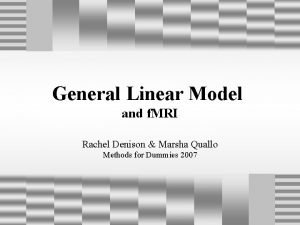Idiots guide to General Linear Model f MRI

















- Slides: 17

Idiot's guide to. . . General Linear Model & f. MRI • f. MRI model, Linear Time Series, Design Matrices, Parameter estimation, *&%@! Elliot Freeman, ICN.

General Linear Model & f. MRI How does GLM apply to f. MRI experiments? Y = X . β + ε Observed = Predictors * Parameters + Error BOLD = Design Matrix * Betas + Error

Observed data Y is a matrix of BOLD signals: Each column represents a single voxel sampled at successive time points. Preprocessing. . . X. β +ε Y Time Y= Intensity

Univariate analysis Each voxel considered as independent observation Analysis of individual voxels over time, not groups over space SPM would still work on an Amoeba! Y= X. β +ε

Continuous predictors Y Y= X. β +ε X • X can contain values quantifying experimental variable

Binary predictors Y Y= X. β +ε X • X can contain values distinguishing experimental conditions

Parameters & error β: slope of line relating X to Y • ‘how much of X • is needed to approximate Y? ’ the best estimate of β minimises ε: deviations from line Y= X. β +ε this line is a 'model' of the data slope β = 0. 23 intercept = 54. 5

Y= Design Matrix Y X 1 X 2 X 1 • Matrix represents values of X Different columns = different predictors X. β +ε X 2

Matrix formulation Y 1 Y 2 YN = X 1(t 1) X 1(t 2) X 1(t. N) X 2(t 1). . . XL(t 1) X 2(t 2). . . XL(t. S) X 2(t. N). . . XL(t. N) (t) ^ = (5 * β ) + (1 * β ) Y 1 1 2 ^ = (4 * β ) + (1 * β ) Y 2 1 2. . . ^ = (X 1 * β ) + (X 2 * β ) Y (t. N) N 1 2 Y= β 1 β 2 βL Y X 1 + X 2 X. β +ε ε(t 1) ε(t 2) ε(t. N) X 1 X 2

Parameter estimation and stats Find betas (by least squares estimation) • Y= βX -> “B = Y / X” (B= estimated β) • Matlab magic: >> B = inv(X) * Y Now find error term: • e = Y – (X * B ) . . . and use these results for statistics: • t = betas / standard error

Covariates vs. conditions Covariates: • parametric modulation of independent variable • e. g. task-difficulty 1 to 6 -> regression: beta = slope Conditions: • 'dummy' codes identify different levels of experimental factor • specify time of onset and duration • e. g. integers 0 or 1: 'off' or 'on' -> ANOVA: beta = effect mean on off on

Modelling haemodynamics Brain does not just switch on and off! -> Reshape (convolve) regressors to resemble HRF Original HRF Convolved HRF basic function

Anatomy of a design matrix Example: • 5 subjects • 2 conditions per • • subject 6 replications per condition 1 covariate

Interesting vs. uninteresting Important to model all known variables, even if not experimentally interesting: • e. g. head movement, block and subject effects • minimise residual error variance for better stats • effects-of-interest means adjusted to eliminate effectsof-no-interest global conditions: activity or movement effects of subjects interest

Selecting and comparing betas A beta value is estimated for each column in design matrix A contrast variable is used to select (groups of) conditions and compare with others e. g. mean β(2 4 6. . . ) - mean β(1 3 5. . . ) t statistic = ( β 1 β 2 β 3. . . ). -1 / SE t-test: t > critical value ? 1 -1. . .

Summary: Reverse Cookery You start with the finished product and want to know how it was made • You specify which ingredients to add (design matrix variables) • For each ingredient, GLM finds the quantities (betas) that produce the best reproduction (model) • Now you can compare your recipe with others (null hypothesis) to see if they differ! (statistical tests)

How dumb was that? Sources: http: //www. fil. ion. ucl. ac. uk/spm/doc/papers/SPM_3/welcome. html http: //www. fil. ion. ucl. ac. uk/spm/doc/books/hbf 2/pdfs/Ch 7. pdf http: //www. mrc-cbu. cam. ac. uk/Imaging/Common/spmstats. shtml
 Idiots guide to gdpr
Idiots guide to gdpr Vfr communications
Vfr communications General linear model minitab
General linear model minitab Cohen 1988 effect size
Cohen 1988 effect size Disadvantages of linear model of communication
Disadvantages of linear model of communication Pengertian primal dan dual
Pengertian primal dan dual What was nocti original product line
What was nocti original product line Nocti general management study guide
Nocti general management study guide Diferencia entre gran plano general y plano general
Diferencia entre gran plano general y plano general Where did general lee surrender to general grant?
Where did general lee surrender to general grant? Mris_preproc
Mris_preproc Mri gp indications
Mri gp indications Ax t2 propeller mri
Ax t2 propeller mri Image formation mri
Image formation mri Is type 1 acromion serious?
Is type 1 acromion serious? How mri works
How mri works Mri hydrogen atoms
Mri hydrogen atoms Frequency
Frequency



